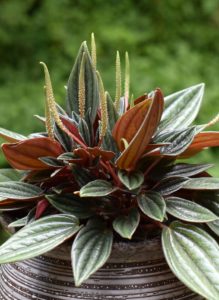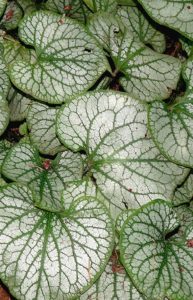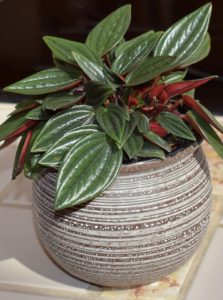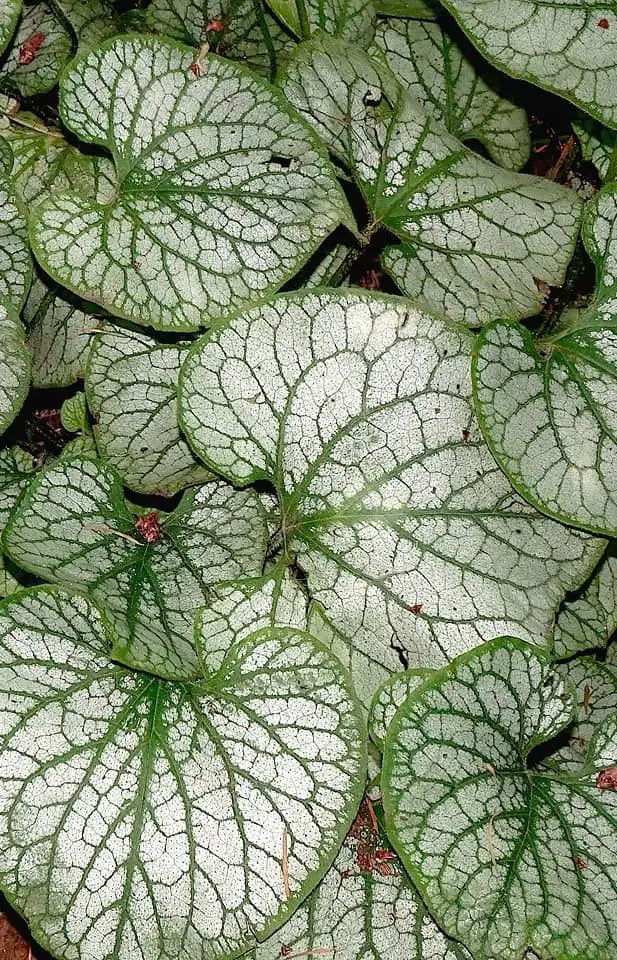Some links in the post are affiliate links and I get a commission from purchases made through some links found in the post.
Peperomia are the best plants for beginners to get their hands on. They are an attractive addition to your indoor collection.
The thick, colorful, and succulent leaves look astonishing. They can be of various colors ranging from red, green, and gray.
The pattern on the leaves also shows great beauty and it may be marbled, striped, or mottled in appearance.
They make great houseplants as they need no effort at all. They can tolerate a wide range of stressful conditions.
Peproimas are prized for their ornamental foliage. The leaves outshine the flowers as they are small, spiky, and scentless.
The Silver Peperemoia Plant
There are many magnificent species of peperomia plants out there. And out of them all, Peperomia frost (Peperomia caperata Frost) is the most impressive.
This plant has silver-green leaves, that look stunning and exotic at the first glance.
The white heart-shaped leaves with dark green veins running along the whole length provide a very unique aesthetic to the plant.
It may look similar to the rex begonias due to the deep ridges of its foliage. This hardy plant is native to the South American Rainforests.
It grows under the cool canopies and shade of the tall trees. Care for this plant is easy and it won’t feel a burden to you at all.
Things to take Ensure for Proper Care of Your Peperomia Plant
Things to ensure of to care for your Peperomia Frost Plant:
1) Maintaining a watering schedule
2) Giving Exposure to Adequate Indirect Sunlight
3) Ensuring Proper Humidity
4) Having the Best Potting Mix
5) Moderate Temperature
6) Pruning
7) Fertilizing the soil
The peperomia frost is a slow-growing species and can range in size from 6 inches to about one foot.
They also don’t spread that much in width. This makes them an ideal choice to be used for small indoor spaces, containers, and dish gardens.
Following are the steps that should be taken care of to make your peperomia frost shine at its best:
1) Maintaining a Good Watering Schedule
 These plants are very hardy when it comes to watering. The only way you can kill your peperomia plant is by overwatering it.
These plants are very hardy when it comes to watering. The only way you can kill your peperomia plant is by overwatering it.
They are resistant to drought conditions and can fare well even if you water them once every week. The signs of overwatering include:
- Squishy and droopy leaves.
- Black stems
The best strategy that should be adopted is to assess the soil before each watering. If the topsoil appears moist, you should wait for it to dry up completely and then water thoroughly.
The plant has a fairly short root system and isn’t that needy in terms of hydration. The fleshy stems can hold water in times of drought and don’t let this affect the health of the plant.
The watering should be gradually reduced in the winter months as the soil can get soggy.
If you overwater the plant by mistake, then this may cause sensitive roots to rot. Pots with good drainage should be used to prevent the buildup of water.
The dryness of the soil should act as an indicator of water needs.
2) Giving Exposure to Adequate Indirect Sunlight
Peperomia plants are naturally found to grow in the rainforests. They are present at the bottom of the canopies.
They are adapted to receive filtered light. Peperomia plants are shadowed by the tall trees in their natural habit and don’t tolerate direct sunlight at all.
They should be placed close to the windows so they can flourish optimally. They do best in bright, indirect light.
Proper care should be taken during summers as the plants are at risk to face strong UV radiation. The excessive direct sunlight can cause leaf scorching which looks unpleasant afterward.
On the other hand, insufficient light will result in a decrease in leaf density and more leaf drop.
The color of the leaves may start to fade off if the condition persists. Exposing the plant to artificial light for 12-16 hours is also a good alternative for solving this.
If you like to grow your peperomia frost outside, then care should be taken to plant them in shady areas or more suitably under the cover of trees.
They will grow well with the filtered light they receive through the tree branches.
3) Ensuring Proper Humidity
Peperomia frost, like other species of peperomia, is a tropical rainforest plant. Due to this reason, it is inclined to grow in a humid environment.
Normally, the indoor humidity level is not enough to support the best growth of the silver peperomia. A 40-50% humidity is adequate for ideal growth.
The simplest solution to this problem is to use a humidity tray underneath the plant. The tray should be filled with water and pebbles.
The pot should not come in contact with water. This water can slowly percolate through the soil and cause damage to the roots.
You can also place your peperomia in a terrarium where it thrives in the moist air just like in the rainforest.
If you have the means, you can also buy a humidifier. This eases your burden of refilling the water in the pebble tray each time it runs out.
4) Having the Best Potting Mix
The peperomia frost plants are like orchids in their potting requirements. They need a mixture of perlite, tree bark, and peat moss to grow best.
They should be planted in pots with drainage holes. This is to ensure that the medium remains dry and aerated at all costs. Excessive overwatering of the medium causes problems such as root rot.
Repotting
 Peperomia plants prefer a snug fit when they are grown in pots. They don’t require repotting that often.
Peperomia plants prefer a snug fit when they are grown in pots. They don’t require repotting that often.
The need may arise to refresh the soil after two to three years. The ideal potting mix is similar to that required by the orchid plants as they are also epiphytes in nature.
You can either repot the plant with a mixture of old and new soil or change the medium completely.
The new pot can be larger than the previous but the plant should remain compactly pot bound.
Proper care should be taken while repotting the plant as the roots are very delicate and can be easily damaged.
5) Moderate Temperature
As the plant is native to tropical regions, it does well in temperatures between 60 to 70 degrees Fahrenheit.
It fares well at room temperature but it’s best not to expose the plant to temperatures below 60 degrees (15 degrees Celcius).
According to USDA, the plant grows best in zones 10 to 12. In cold weather, they should be shifted indoors to save them from frost damage.
6) Pruning
Peperomia frosts, like other peperomias, don’t grow and spread that much in size. When they are placed away from sunlight, the plant may show some added growth towards the source.
You can tone down the spread by using sterile shears. Using clean shears helps prevent the entry of pathogens into the plant’s system.
The best time for pruning is in the spring as it is the best time for their growth. Cutting the leaves will enable the plant to bud new leaves and give it a more shrubby and fuller appearance.
7) Fertilizing the soil
Fertilizing the peperomia frost in early spring is the best way to care for its growth.
You should use a dilute ordinary water-soluble fertilizer every week in the spring. Proper nutrition for the plant is essential in these actively growing months.
Winters are relatively less demanding. The plant has no special needs during these cold months.
Avoid adding fertilizer in these dormant conditions. Unintentional over-saturation of soil with nutrients also leads to plant death.
You may also like: How to fix a leggy pilea
Common Issues with Peperomia Frost Plants:
As already mentioned, peperomia plants are very hardy and resistant to most of the challenges nature has to offer them.
But problems do arise when you least expect them to occur. Following are the most common issues that you may face:
1) Pest Infestation:
The common insects which disturb the plant include mealybugs, mites, and whiteflies. They suck the sap of the plant and make the leaves look droopy and flaccid.
They can simply be taken care of using organic pesticides like neem oil. If you ever find snail or slugs on them, you can use baits for them to prevent damage to the foliage.
2) Root Rot and Fungal Infection:
Root rot and fungal infections are more or less related to overwatering of the plant. Signs of these diseases include discolored, droopy leaves along with black, mushy stems.
The only way to prevent them is to maintain a proper watering schedule. Watering only when the soil appears to become dry, is the best strategy to adopt
Final Thoughts: How to Care for your Peperomia Frost Plant?
 Peperomia Frost plant is an absolute treat to the eyes. It has a special place in the hearts of home gardeners due to its simple yet captivating looks.
Peperomia Frost plant is an absolute treat to the eyes. It has a special place in the hearts of home gardeners due to its simple yet captivating looks.
Maintaining this elegant plant should not be a problem as this is very easy in the hands of a beginner.
By knowing all these ins and outs of the plant you can be sure that you won’t have to face any issue in the future.
About the Author:
Saad Ansar
Saad is an avid gardener himself and is a great lover of plants, animals, photography, & people. Currently, he is focused on photographing indoor plants & captioning beautiful outdoor sceneries. He writes and rewrites in-depth articles on nature and science.


